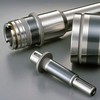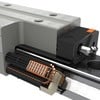Considerations For An Actuator of 4 Feet Or Less
Featured Product from NB Corporation of America
Traditionally, many equipment manufacturers designed and assembled their own, custom, ball screw actuators. In fact, many semi-conductor manufacturers and medical equipment manufacturers still do. To design custom stages, engineers have to design the ball screw size, i.e., find the right ball screw, carriage and guide rails – the three main components. They’d also have to have supports for the ball screw on both ends and motor brackets. After mounting all the components adjustments have to be made – repeatedly.
Many companies have recognized the advantages of purchasing an off-the-shelf system solution as opposed to taking components and building their own system. Typically, ball screw actuator systems come in at least 5 different stage sizes. They have several travel length options and there are other options already designed. Once the engineer identifies the optimum system, he or she just has to get the right motor.







